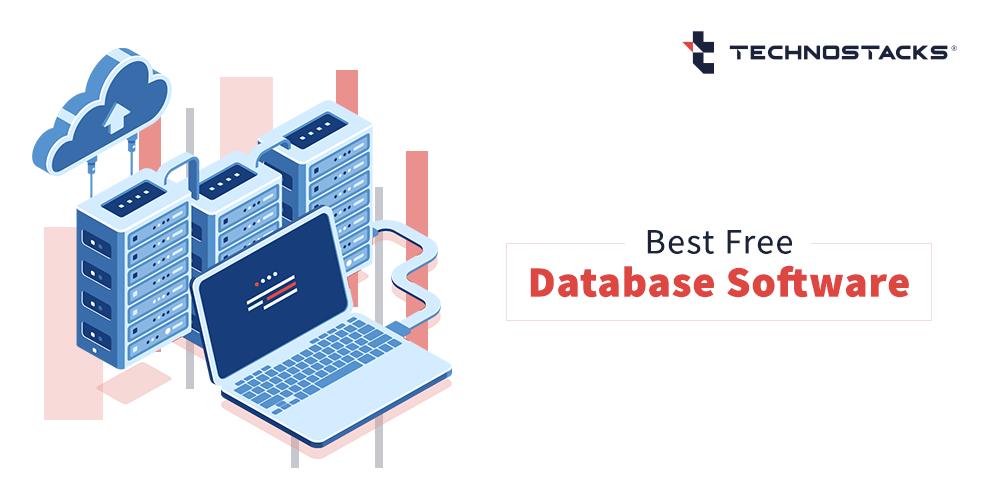Top 20 Open Source & Free Database Software For Your Next Project
Database softwares has been used in the industry for a long time now, and today, they are more important than ever. With the new age 5G revolution at bay, a lot of things are changing. For instance, big data is driving wife networks and archives by simply loading up archives of information.
In this information age, it is clear that one can easily get more out of their work with a good deal of information. However, not all database software is free to use.
Research shows that upward of 2.5 quintillion bytes of data are being produced daily. Therefore almost every organization needs database software. To make it easy for you, here is a list of free databases to use.
The Best Free Database Software to Utilize in 2025
1. InterBase
Database softwares today needs to be more versatile than ever before. Their performance heavily depends on their versatility as they should be adaptable to various platforms like android, windows, Linux, etc.InterBase can be embedded into such applications with ease, making it special database software. Moreover, its encrypted system makes it secure to use and easy to procure from anywhere.It is software made for efficiency and speed. The boot and install system works in a jiffy, and you can have it up and running as and when you want it. The best part about it is the multi-language support that offers a wide range of services across various people.
Key Features
- Security features include separate login for security.
- No maintenance is required.
- Live backups are available.
- Supports multiple languages
- It’s lightweight.
2. Microsoft SQL
Many have preferred the SQL server over standard database systems in recent times. It is free database software. This system supports ANSI SQL, which is the basic support for every language and has various languages running in like JavaScript, C++, and more.The SQL server has its own understanding of the language, which is a unique feature to it. This software has been up there rivalling the big names thanks to its unique design. This makes it software with great structure and open-source database tools that help you through and through.Thanks to efficient features, it can provide you with structured data as well as unstructured data for your information. You can improvise on your data scalability and performance with the help of the tool provided.
The advanced features offered can keep your data safe and secure. The power BI reports provided are interactive, which help you to boost the understanding of your data and customize it according to your preference.
Key Features
- Spark and SQL enable unstructured and structured data integration.
- Power BI reports can be accessed.
- The connector library can combine data from anywhere.
- Allows access based on the roles of users.
- Built-in data protection, monitoring, and classification features.
3. MY SQL
One of the earliest additions to the list, the MySQL server, has been around for a while. It is an Open-Source Database Software that provides users with adaptability for Windows, Mac, and Linux. It is accessible in a large number of languages from Python, Java, C++ and many more. It is best known for the flexibility as well as the scalability of the data provided.It practically acts like a separate warehouse of data for your information and has much strength that most of its competitors will not possess. There is also an additional robust transactional support feature that it has for the new Windows 10 version. If you have a website with a high volume of data, you will perhaps get the most of MY SQL and its many advantages for the same.
Key Features
- It has strong transactional support.
- Possesses data warehouse strengths.
- Uniform record is kept in the data dictionary.
- Group attributes can control hardware consumption.
- Privileges can be easily set be roles like read-only access.
Enterprise-level software for databases is hard to find these days, but somehow, PostgreSQL manages to make it look easy. The support that it offers for relational and non-relational queries is very useful for anyone who needs enterprise-level tools, and its able functions work wonders for your data management.The open-source platform also has been specially designed for efficient database management that helps you to store all kinds of stacks of information.This is an object-oriented tool and has functionality across a wide range of complex requirements.
Key Features
- It’s compatible with ANSI-SQL 2008.
- Server-side programming is matured.
- SSL replication is trigger-based and log-based.
- A sophisticated mechanism for locking.
- It can link with other frameworks like NoSQL.
5. MongoDB
The Mongo database has ensured that it creates a lasting name in the industry with its high-level functions and efficiency for high volume data storage requirements. It is a special database because it falls under the category of NoSQL bases and ensures that everyone can access it with its simultaneous flare. The cross platform features are additionally very useful.There can be just one of the SQL Databases list that perfectly fits your needs. Try using some of these to get the hang of which one suits you the best.The free open-source platform doesn’t just keep your data, but it secures it via its cloud backup system that keeps your data safe and protected. In addition, your clusters that can be distributed globally are easily created in this software.
Key Features
- Monitor, visualization, and alert is offered on more than 80 metrics.
- It has a global cloud database- MongoDB Atlas.
- Its query language is very rich.
- A full-text search function is integrated.
- A data app driven by data can be triggered in real-time.
6. Orientdb
While orient DB is a NoSQL platform, it’s features will make sure that you end up using it sooner rather than later. It supports scalability and boosts performance so that you don’t have to worry about your database ever again. It is one of the top free databases in its field, all thanks to its speed and efficiency.The application is generally for having a custom way of dealing with high quantity data. Despite being free, the planner has a feature of an enhanced query planner.
Key Features
- TinkerPop 3 is available for quick updates.
- Multi-Model AP is there for fast deployment.
- An effective query planner is provided.
7. MariaDB
The way the MySQL data management system works today can largely be in the footprint that MariaDB has left. While drawing a comparison database name list is difficult, MariaDB is perfect for small as well as large scale tasks.It has the support for many programming languages and can run on most systems without breaking a sweat. It supports a number of coding languages so that coders do not have a problem and has a quick fix for most problems faced by database management systems.The Galera technology of clusters is very important to many database management enthusiasts, and this programme has it in its open-source version. It is so good that many see it as a direct alternative to MySQL. The prowess it offers through integration and scalability is really good. And of course, if you are thinking of upgrading from MySQL to MariaDB, it’s possible to carry out a comprehensive migration so long as you use the right tools and tactics.
Key Features
- Its license is BSD, GPL, or LGPL.
- Enables Galera Cluster technology.
- Several store engines are there.
- Several programming languages are supported.
8. SQLite
Designed post 2000, as the name suggests, this system is light and efficient. Having this database on your device will take virtually no time as it requires no configuration at all. There is no server requirement for installation, and it is extremely late. Even though it is simple and a tad bit old school, you will find that the simplicity is accompanied with this.The lightweight of it on your system helps you to have a comprehensive data unit that does not take up too much space. This makes it probable and quite possible for you to carry it wherever you go easily.If you are thinking about a database that is dedicated to storing, you’re looking right. Despite choosing the basic lightweight version, you will find that the quality is up to date with the latest features and trends. It is a reliable engine that will certainly run for years to come and will give you the best features at most time consuming.
Key Features
- Provides access to the in-memory library.
- It’s extremely lightweight compared to others like Oracle.
- No dedicated server is required for storing the database. The computer’s hard disk can be used.
9. Cassandra
This tool is very helpful for people who are looking to make an open-source base platform but without having to put in a lot of work at the beginning.The data is collected across a wide range of servers, and then you decide this work is good. Without any network bottlenecks, this software does extra well to meet all the requirements that one may usually have.It does have a cloud version, much like many leading names in the business today and works on most codes known by captains. You can even draft contracts from services or contact via 3rd parties to take full benefit.
Choosing between the update is not a feature that one generally gets, but this one allows you to choose.
Key Features
- Third-party contracts are supported.
- The fault-tolerance program copies data to several nodes.
- Choice from asynchronous and synchronous replication to update.
10. Oracle
Not many software’s come like Oracle. At initial glance, it does not look like something very capable, but now it has become the go-to software for everything.This software has a special function through which you will not have to worry about taking care of its basics. This software will repair and update itself from time to time so that there isn’t a problem.The database is available very easily and can expand as per your needs. This is one reason why people prefer oracle because of the various functions it has to offer.
Key Features
- Provides easy migration to Cloud.
- It can tolerate high workloads and big data.
- Provides custom-based services.
11. IBM Db2
IBM Db2 is probably the best free relational database software. Storing, analyzing, and retrieving data on IBM Db2 is extremely efficient.
Key Features
- Various features of NoSQL are supported by IBM Db2, including graph store, XML, and JSON.
- It supports most data science languages like PHP, Python, Jupyter, and Java.
- High availability disaster recovery (HARD) is available in Db2 when the sites fail.
- Another significant feature of this free database software is low-latency transactions.
- It can work efficiently on all operating systems such as Linux, Windows, Mac, and Unix.
12. Amazon Relational Database Service (RDS)
RDS allows deploying and scaling relational database engines of choice. It automates time-consuming administrative tasks.The most praiseworthy free database tools include AWS RDS command-line interface, Amazon RDS Management control, and simple API calls for a fast setup.
Key Features
- This free simple database software supports other engines, including Amazon Aurora, Oracle Database, PostgreSQL, SQL Server, and MariaDB.
- Tools like multi-factor authentication and Virtual Private Cloud (VPC) can restrict access to databases.
- Security audits and patching enhance the security arrangements.
- Data protection and snapshot restoration arrangements are there for solid disaster recovery.
13. Couchbase
Couchbase is a distributed NoSQL cloud database. This document-oriented database is based on two advanced NoSQL technologies- CouchDB and Membase. It is goal-based free database software that provides tools tailored to users’ needs.
Key Features
- It is scalable, versatile, and financially valuable database software.
- Data structuring is easy because data is saved in JSON format.
- The language for JSON is SQL-friendly.
- Its SDK has complete integrations with Scala, Java, JavaScript, Go, Python, and . NET.
- Syncing data in Couchbase is accessible as the data is stored in buckets like RDBMS.
14. ArangoDB
ArangoDB is open-source document-oriented freeware database software. It is written in C++. It works on almost all operating systems such as Windows, Linux, macOS, Docker, and Kubernetes. This supports three data models, including document, graph, and key-value data models.All these can be mixed in a single query enabling smooth functioning.
Key Features
- ArangoDB Query Language (AQL) can be used for accessing any data irrespective of its model.
- Its multi-model database software allows users to merge several NoSQL databases into one infrastructure.
- The users can also scale the applications horizontally as well as vertically.
15. Neo4j
Neo4j is graph database software. It is again database software free for users. Since it’s a graph database, it is easier to interpret information from the most complex models. Building and retrieving data relationships is straightforward because of the non-involvement of queries like SQL Joins.
Key Features
- The query data can be exported to XLS and JSON formats.
- It uses Cypher Query Language, which is a powerful query language.
- This top database 2024 has “whiteboard-friendly” modeling.
- Native Java API and Cypher API are the two types of Java API.
16. Dgraph
It is probably the best database 2024 for open-source graph database software. It uses a single schema approach for its database and backend development. It doesn’t require any code to use this schema.
Key Features
- Numerous open standards like Protocol Buffers, gRPC, Open Census, and Go contexts are supported.
- Users can update the schema as well as the graph. Also, there is a built-in Dgraph GraphQL.
- Business logic can be created instantly using its Dgraph Lambda feature.
17. Tigergraph
Tigergraph is enterprise-level free simple database software that is highly scalable. It allows the handling of huge as well as complex databases in a quick time.Tigergraph is highly scalable database software that offers trillion-edge graphs for real-time analysis. That’s why it’s one of the best free databases.This single app combines all the features of research on graph data.
Key Features
- It can process at a high pace of 100GB per hour/node.
- A high-performance language- GSQL query language, is used.
- Has an easy-to-use and robust Graphical User Interface- GraphStudio.
18. InterSystems Cache
InterSystems Cache is object-oriented free database program software. It contains all the functions for running goal-based apps.
Key Features
- Provides access to an application server hosting REST, web applications, SOAP, TCP access, and web sockets.
- Controls data efficiently through Java, SQL, .NET, Node JS, Python, and C++.
19. InterSystems Iris
InterSystems Iris is again one of the best free database software object-oriented. It is an advanced tool to produce IT professionals’ data connectivity and ML solutions. It acts as a free SQL database and free NoSQL database solution as well.
Key Features
- Vertical scaling is allowed.
- Specialized applications, including SQL, ML, analytics, Natural Language Processing, and low-code, can be built with this.
- Data is stored in multi-dimensional arrays.
20. GigaSpaces
GigaSpace is one of the object-oriented database software. Its innovation of in-memory technology provides highly scalable, fast, and efficient outputs. It finds solutions to the most complex analytical problems. The Smart Digital Integration, as well as Smart Cache systems, are powered by its in-memory technology for computation.
Key Features
- The ACID compliance is preserved against any data via the complete semantics of the transaction.
- Users can also employ SQL query semantics to documents, POJOs, and GeoSpatial data.
Key Takeaways
Having a best Database Software list is very difficult as everyone who requires these has a different requirement.
These requirements make separate software for separate people perfect. Connecting via various features can be a boon to you, and it is recommended that you do not rush into a new connection despite the limitations.
So, the best idea is to take a try and decide which software works the best for you.
We at Technostacks, have an expert web and mobile app developers team who have a large experience in working with above listed databases. We offer database management services globally.
Explore our work portfolio and connect with us for your database project requirements. If you have any questions regarding the article then feel free to comment below.
FAQ’s
1. What is Database Software?
Database software is specific software that can store information and additionally use it later for anything that you require. This usage of stored information is what makes database software desirable.Databases are of two types- Sequential or Relational databases (SQL) and Non-Sequential or Non-Relational databases (NoSQL).
2. Which is the best free database software?
InterBase, Microsoft SQL, MY SQL, PostgreSQL, and MongoDB are some of the best free database software available.However, what can be suitably best for one user isn’t necessarily best for the other. It depends on respective users and objectives.For instance, free database software for windows 10 might not be the best choice for another operating system.
Generally, software with high scalability, performance, diverse integrations, and multiple OS support is considered the best.
3. Which free database software can you use?
You can use any free database software that you think suits your needs. You should try out using a few free database softwares and then decide which one suits your work the best.Choose the one that aligns with your aims and objectives.
4. How can you choose the best Database Software?
Choosing the best database softwares is easy when you are knowledgeable about the best ones out there. You can try them out and choose for yourself as there is no one database software that serves everyone the same.What can be best for one person might not suit the other. Therefore choose according to herefore choose according to your needs.
5. What is the easiest database software to use?
Depending on your requirements and familiarity with data-driven tools, you can find easy data storage softwares to use. If you’re new, you can even search for database softwares for beginners.Different software with different difficulty levels is available in the market. Hence, you can choose accordingly after evaluating its features.
6. Does Google have a free database?
The Google Cloud SQL is free software that gives you many handy features that you would want from database software. You can easily find this software online and download it free of cost.You can access it from the cloud SQL instances page from the google cloud console. Then click on the instance and select database.
7. Is SQL free software?
SQL is ultimately a paid software that offers you a free trial period in which you can try out the software and choose whether you want to continue using it or not.
8. Is there a free alternative to Microsoft Access?
For your database needs, you can peruse this list to find various alternatives to Microsoft access with similar features that are completely free of cost.
9. Is there any free database?
MySQL, Microsoft SQL Server, and MongoDB are free database software that you can use for managing the details of your project.There exist numerous free databases on the market. Even though every database is not as efficient as the paid ones, some of them, like those mentioned above, are worth considering.In fact, in some cases, these free databases even surpass the paid data databases. These open-source databases provide robust and resilient database tools for an extensive array of tasks.
10. Where can a database be created for free?
MySQL, PostgreSQL, MongoDB, and OrientDB are the place where you can create a database for free!You can easily create and operate databases for free on the software mentioned above efficiently.Apart from those, several free online databases are available in the market if you use databases sporadically. These include lifewire.com, grubba.nat, obvibase.com, kohezion.com, zoho.com, and sodadb.com, among others.
11. What SQL databases are free?
Yes, there are numerous SQL databases for free. And the major ones have already been mentioned above, such as MySQL and PostgreSQL.Also, there are online options available for the same. There are different databases suitable for different operating systems. For example, MySQL is among the best free database software for windows 10.







